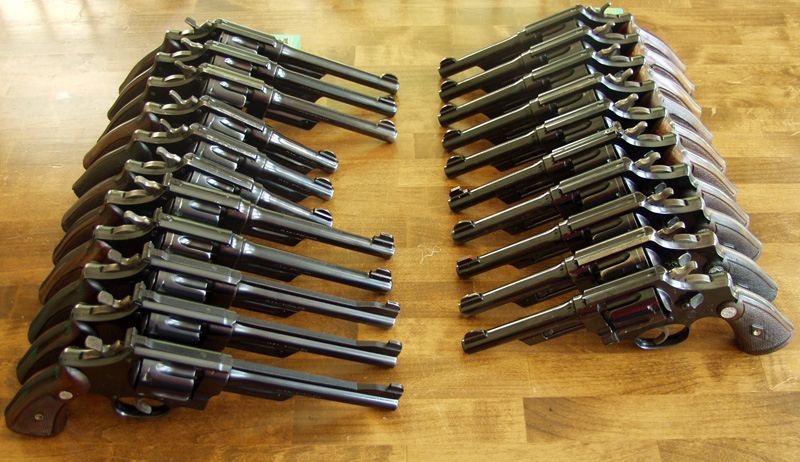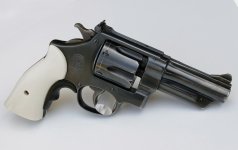You are using an out of date browser. It may not display this or other websites correctly.
You should upgrade or use an alternative browser.
You should upgrade or use an alternative browser.
Anyone familiar with the S&W 38-44 frame revolver?
- Thread starter Boncrayon
- Start date
There were two versions, the normal sighted .38-44 Heavy Duty and the .38-44 Outdoorsman, which had adjustable sights. The .38-44 was called that because it was a .38 caliber on the .44 frame.* The Heavy Duty was introduced in 1930, the Outdoorsman in 1931. They were designed for use with the more powerful .38 Special loadings being introduced in that period, including a metal penetrating round capable of penetrating auto mobile bodies.
The .38-44 was built on the large N frame, which was also used in the later .357 Magnum, but the .38-44 would not chamber the .357 Magnum unless someone reamed out the chambers. That practice was not recommended because the .357 had different heat treatment in the cylinder and was therefore stronger than the .38-44. The .38-44 was the platform used by Elmer Keith and S&W in developing the .357 Magnum, but was not chambered for the .357 Magnum.
When S&W went to model numbers around 1957, the .38-44 Heavy Duty became the Model 20; the .38-44 Outdoorsman became the Model 23. The .357 Magnum N frame became the Model 27; a plain version became the Model 28.
*There had been an earlier .38-44 target cartridge different from, and not interchangeable with, the .38 Special cartridge used in the .38-44 revolver under discussion.
Jim
The .38-44 was built on the large N frame, which was also used in the later .357 Magnum, but the .38-44 would not chamber the .357 Magnum unless someone reamed out the chambers. That practice was not recommended because the .357 had different heat treatment in the cylinder and was therefore stronger than the .38-44. The .38-44 was the platform used by Elmer Keith and S&W in developing the .357 Magnum, but was not chambered for the .357 Magnum.
When S&W went to model numbers around 1957, the .38-44 Heavy Duty became the Model 20; the .38-44 Outdoorsman became the Model 23. The .357 Magnum N frame became the Model 27; a plain version became the Model 28.
*There had been an earlier .38-44 target cartridge different from, and not interchangeable with, the .38 Special cartridge used in the .38-44 revolver under discussion.
Jim
Last edited:
Ditto.
About half the 38/44 "Heavy Duty" revolvers encountered have been reamed for 357 Magnums. Not recommended. Will still shoot 38s OK.
Pre-war the 5" was most common. Post-war the 4" is mostly seen. The 6.5 is rare. I heard one 8" was made on special order but not sure if true and I have no details.
Maybe you are real lucky and have that one?
When the 357 Combat Magnum came out in 1955 the 38/44 sales fell off the table. It limped along in the catalog until 1964. Few were made or sold. Very few stamped with a model number. I have one with a serial from 1956 that was shipped in 1960 showing how slowly they were moving.
About half the 38/44 "Heavy Duty" revolvers encountered have been reamed for 357 Magnums. Not recommended. Will still shoot 38s OK.
Pre-war the 5" was most common. Post-war the 4" is mostly seen. The 6.5 is rare. I heard one 8" was made on special order but not sure if true and I have no details.
Maybe you are real lucky and have that one?
When the 357 Combat Magnum came out in 1955 the 38/44 sales fell off the table. It limped along in the catalog until 1964. Few were made or sold. Very few stamped with a model number. I have one with a serial from 1956 that was shipped in 1960 showing how slowly they were moving.
If you want to know what the original 38/44 round was like to shoot get a box of Buffalo Bore's Heavy 38 Special +P 158g SWCHP-GC. They deliver the same performance (1140 fps from 4"-5" bbl) as the original 38/44. They are a kick!
If you hand load, try 11.5g to 12g of 2400 behind a 158g bullet. It will get you in the same velocity range. It's all I shoot any more in my 1937 vintage Heavy Duty and all my 357s.
Dave
If you hand load, try 11.5g to 12g of 2400 behind a 158g bullet. It will get you in the same velocity range. It's all I shoot any more in my 1937 vintage Heavy Duty and all my 357s.
Dave
Bob Wright
New member
As a matter of interest, Phil Sharpe had more to do with developing the .357 Magnum than Elmer Keith.
Bob Wright
Bob Wright
carguychris
New member
True- and I'd like to bring up a related topic regarding the .38/44 HD.About half the 38/44 "Heavy Duty" revolvers encountered have been reamed for 357 Magnums.
Although production numbers were only a small fraction of pre-WWII K frame .38Spl output, the .38/44 HD was, for many years, by far the most numerous N frame. IIRC its production figures outstrip all other prewar commercial N frame models combined (excluding WWI-era military M1917 and .455HE production). Furthermore, much of the factory's output was snapped up by law-enforcement agencies, many of which later converted to the more capable yet lighter .357 Combat Magnum / Model 19. The result by the late 1950s was a relative abundance of low-priced shooter-grade .38/44 HD's on the secondary market.
One result was that the .38/44 HD became fodder for many gunsmith conversions to either emulate the exclusive and expensive N frame .357 Magnum / Model 27, or to fire other cartridges for which factory guns weren't readily available. Although I don't recommend trying it today, .38/44's are generally strong enough to withstand firing at least some .357 Magnum ammo once the chambers are lengthened to allow the longer cartridge to fit.
Another result was that demand for new .38/44's fell off the proverbial cliff, as stated above.
The final result is that unmolested original .38/44 HD's have become quite collectible over the last few years, including so-called shooter-grade or even "beater-grade" guns. The primary reason is that many original ones had the barrels cut, different sights installed, chambers lengthened, etc. by Joe Gunsmith ca. 1965.
Bob, you are right on; I confused the two gentlemen. Keith had a lot to do with the .44 Magnum but at the time the .357 came out he was almost unknown. FWIW, Sharpe got .357 registration number 2; J. Edgar Hoover got #1, serial number 45768.* The other key players were Merton A. Robinson of Winchester, who helped develop the cartridge, and, of course, Douglas Wesson, who was instrumental in deciding to manufacture and promote the new caliber and new gun.
*The .357 was not numbered in its own series but in the .44 HE series.
Jim
*The .357 was not numbered in its own series but in the .44 HE series.
Jim
newfrontier45
Moderator
Keith's .38-44 loads develop more pressure than modern .357 loads. In excess of 42,000psi if I remember right. So I while I wouldn't use original .357 loads in a rechambered .38-44, I wouldn't hesitate to use current 36,000psi .357 data to load for a .38-44. Cylinder length will be a problem for some bullets in .357 cases.
Keith experimented heavily with the .38-44 but the .357 was Phil Sharpe's baby.
Keith experimented heavily with the .38-44 but the .357 was Phil Sharpe's baby.
IIRC, Keith didn't think too highly of the .357 in his Sixguns book, which is of course required reading for anybody that likes revolvers. 
My Heavy Duty is field grade but not in bad shape, as long as I am not too hung up on blueing. I mean, the scratches are very minor, the screws look good, and there are zero rust pits. I am very happy to have a '55 or '56 production gun since that means all the important post-war upgrades are in it.
I like my S&W 1917 guns, but the shorter, faster action of the post WW2 guns is better. And I will not hesitate to shoot any +P ammo, maybe even +P+.
Now that I've mentioned it, what sayeth you guys about +P+ in the HD from the 1950's?
Bart Noir
My Heavy Duty is field grade but not in bad shape, as long as I am not too hung up on blueing. I mean, the scratches are very minor, the screws look good, and there are zero rust pits. I am very happy to have a '55 or '56 production gun since that means all the important post-war upgrades are in it.
I like my S&W 1917 guns, but the shorter, faster action of the post WW2 guns is better. And I will not hesitate to shoot any +P ammo, maybe even +P+.
Now that I've mentioned it, what sayeth you guys about +P+ in the HD from the 1950's?
Bart Noir
newfrontier45
Moderator
I don't fart around with squirrel guns much.Personally, I think you should re-chamber for .454 Casull.
Re-chambering a Model 1917 for .454 Casull would be interesting. So would loading. First you load a primed case, then bring the case so it will be under the hammer when you cock the gun, which you proceed to do. Then you load the powder and the bullet from the muzzle. Then you fire and it is a tossup whether the old cylinder lets go before the unsupported brass at the rear of the cylinder sprays out. Lots of fun!
Jim
Jim
Jim Watson
New member
Hey, Chris,
Joe Gunsmith and Hamilton Gunsmith are STILL doing things to .38-44 HD and OD that would make your typical Internet 1911 speculator faint from the shock.
Joe Gunsmith and Hamilton Gunsmith are STILL doing things to .38-44 HD and OD that would make your typical Internet 1911 speculator faint from the shock.
Peter M. Eick
New member

I am kind of partial to them. These were all of my 38/44 Heavy Duties, but sadly the picture is out of date again. 3 more have been added....

